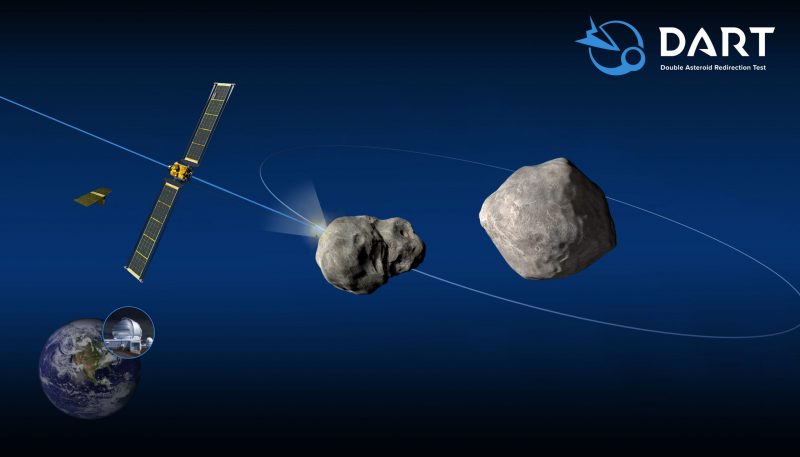Target practice time!
Article by Kelley Kizer Whitt in EarthSky
DART mission to hit and move an asteroid
DART mission targets Didymos B
NASA will soon launch its first planetary defense test mission, called DART (Double Asteroid Redirect Test). The launch window will open on November 24, 2021. The goal of the DART mission is to strike a small asteroid and minutely change its orbit. In recent decades, it’s become clear that asteroids do have the potential to strike Earth and cause damage. The DART mission is a test run for when Earth is faced with an incoming asteroid that’s threatening our planet. DART will arrive at its target asteroid in late 2022 with a impact, becoming the first Earth mission in our history to deflect an asteroid.
DART’s target asteroid is a moonlet of a larger asteroid. The large asteroid is Didymos, 2,500 feet (780 m) in diameter. Its companion, Didymos B (or, sometimes, Dimorphos) is 525 feet (160 m) in diameter. That’s more typical of the size asteroid that might unexpectedly threaten Earth, these astronomers said. That’s because the larger asteroids are easier to see, and their orbits are better known.
Didymos is itself classified as a Potentially Hazardous Asteroid (PHA). By definition, such asteroids have a minimum orbit intersection distance of 0.05 AU (Earth-sun units of distance) or less and an absolute magnitude of +22 or less. In other words, all asteroids that can’t get any closer to the Earth than 0.05 Earth-sun distances – roughly 4,650,000 miles (7,480,000 km) – or are smaller than about 500 feet (140 m) in diameter are not considered PHAs.
Being a Potentially Hazardous Asteroid does not mean Didymos is on a collision course with Earth. It is not. But, in 2003, Didymos did pass only slightly closer than the minimum distance for PHAs. It passed only 0.048 AU from Earth. It was still millions of miles away from us.

This is only a test
But this mission is a test. It’s only a test of what might someday become a full-blown planetary defense program. Didymos and its moonlet Didymos B are not a threat to Earth at this time.
The DART spacecraft is on a kamikaze mission to Didymos (NASA calls it a kinetic impactor mission). It’ll deliberately crash itself into the moonlet at a speed of approximately 4.1 miles/s (6.6 km/s). DART will use an onboard camera (named DRACO) and sophisticated autonomous navigation software to measure the size and shape of Didymos B and to provide detailed views of the site where it will slam into the asteroid.
I know what you’re thinking. If NASA pushes Didymos B off its regular orbit, could it cause the moonlet – or its larger parent asteroid Didymos – into a new path that could possibly be a bigger threat to Earth? These scientists said no, neither Didymos nor its moonlet will become a threat to us because of DART. But that doesn’t mean debris from the impact won’t hit Earth. More on that in a moment.
This test by NASA is an attempt to keep us safe. The effect of DART on Didymos B will be minimal, but still enough for scientists to measure. As NASA said:
Scientists think the collision will change the speed of the moonlet by a fraction of one percent and alter its orbital period around the larger asteroid by several minutes — enough to be observed and measured by telescopes on Earth.
The idea is that, if we were ever to discover a small asteroid on a collision course with Earth, we’d have had some practice in deflecting asteroids away from us.

Meteorites from DART
Here’s a cool aspect of the DART mission. Some scientists believe bits of the debris will eventually hit Earth. A March 23, 2020, paper in The Planetary Science Journal said:
Because the closest point of approach of Didymos to Earth’s orbit is only 6 million km (about 16 times the Earth–moon distance), some ejected material will make its way sooner or later to our planet, and the observation of these particles as meteors would increase the scientific payout of the DART mission.
The DART project may also represent the first human-generated meteoroids to reach Earth.

Didymos A and Didymos B
The asteroid Didymos A and its companion Didymos B were unknown until 1996, when the Spacewatch survey at Kitt Peak National Observatory in Arizona picked up the pair.
Didymos B snuggles close to its parent, orbiting at a distance of just over a half mile or 1 kilometer. It takes the moonlet about 12 hours to complete one orbit of Didymos. Like our moon, the moonlet is tidally locked to Didymos, always showing the asteroid the same face.
At present, scientists said, the Didymos binary asteroid is being intensely observed using telescopes on Earth. They want to obtain precise measurements of its properties before DART arrives.
DART will launch aboard a SpaceX Falcon 9 rocket from Vandenberg Air Force Base in California. After separation from the launch vehicle and over a year of cruise it will intercept Didymos’ moonlet in late September 2022, when the Didymos system is within about 7 million miles (11 million km) of Earth. The relatively close distance between Earth and the asteroid at that time will let scientists observe the asteroid at the time of impact with ground-based telescopes and planetary radar.
They’ll be watching and hoping to measure a change in momentum, imparted to the moonlet.
Bottom line: The DART spacecraft’s launch window opens in late November, for arrival at asteroid Didymos and its moonlet Didymos B in October 2022. Scientists plan to crash it into Didymos B to see how much the moonlet moves, as practice for dealing with potential future dangerous space rock encounters.
https://earthsky.org/space/dart-mission-strike-move-asteroid-launch-2021/



